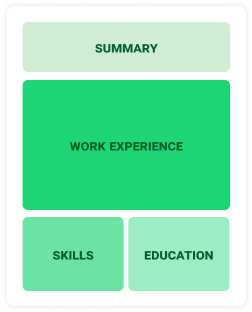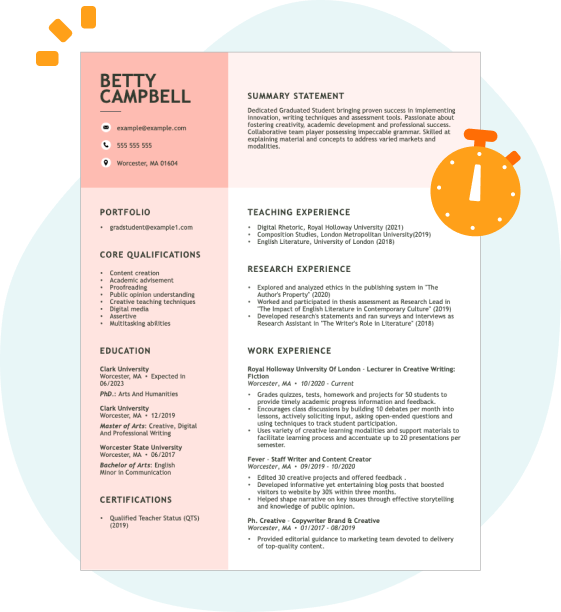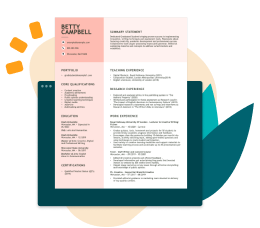Hard skills are technical abilities, including knowledge of scaffold design, skill in using construction tools, and understanding safety regulations that ensure structural integrity.
Popular Scaffold Builder Resume Examples
Check out our top scaffold builder resume examples that demonstrate key skills such as structural design, safety compliance, and teamwork. These resumes will help you effectively showcase your qualifications to potential employers.
Ready to build your own impressive resume? Our Resume Builder offers user-friendly templates specifically designed for construction professionals, making your application process smoother.
Entry-level scaffold builder resume
This entry-level resume for a scaffold builder effectively highlights the applicant's strong foundation in scaffolding setup, safety inspection, and project management through detailed responsibilities and achievements. New professionals in this field should demonstrate their technical skills and commitment to safety while showcasing any relevant projects or certifications to attract potential employers.
Mid-career scaffold builder resume
This resume effectively presents key qualifications through detailed experience in scaffold construction and safety management. The job seeker's progressive responsibilities demonstrate readiness for leadership roles, showcasing a commitment to efficiency and team coordination in complex projects.
Experienced scaffold builder resume
This work history section demonstrates the applicant's extensive experience in scaffold building, highlighting achievements such as reducing setup time by 15% and improving safety records by 40%. The clear formatting allows employers to quickly assess skills and accomplishments relevant to construction projects.
Resume Template—Easy to Copy & Paste
Min Zhang
Oakridge, OR 97467
(555)555-5555
Min.Zhang@example.com
Professional Summary
Experienced Scaffold Builder with 8 years in construction, leading projects to 25% safety margin increase. Proficient in OSHA compliance and team management, achieving 98% safety score.
Work History
Scaffold Builder
Precision Scaffolding Solutions - Oakridge, OR
January 2022 - October 2025
- Constructed scaffolds over 25% above safety norms
- Trained over 50 new hires in scaffold safety
- Reduced material waste by 15% annually
Construction Scaffold Installer
Reliable Build Corp - Portland, OR
January 2018 - December 2021
- Installed scaffolding for 33 high-rise projects
- Achieved 98% safety audit score consistently
- Optimized scaffold setup by 20% in efficiency
Industrial Scaffold Erector
Metropolitan Construction Services - Portland, OR
January 2017 - December 2017
- Managed scaffold assembly for 1M contract
- Led a team of 10 in scaffold inspections
- Ensured compliance with OSHA by 100%
Languages
- Spanish - Beginner (A1)
- French - Beginner (A1)
- German - Beginner (A1)
Skills
- Scaffold Design
- OSHA Compliance
- Safety Training
- Team Leadership
- Project Management
- Materials Optimization
- Efficiency Improvement
- Problem Solving
Certifications
- Certified Scaffold Builder - National Safety Council
- OSHA 30-Hour Construction Safety - Occupational Safety and Health Administration
Education
Master's Construction Management
Illinois State University Normal, Illinois
December 2015
Bachelor's Civil Engineering
Lincoln College Normal, Illinois
May 2012
How to Write a Scaffold Builder Resume Summary
Your resume summary is the first opportunity to impress hiring managers, so it's essential to make it count. As a scaffold builder, you should emphasize your hands-on skills and experience in constructing safe and efficient structures.
Highlighting your expertise in safety protocols, project management, and teamwork will set you apart from other applicants. This profession demands a strong emphasis on practical knowledge and reliability.
To illustrate what an effective resume summary looks like, consider these examples that demonstrate both successful elements and common pitfalls:
Weak resume summary
I am a skilled scaffold builder with years of experience in various construction projects. I seek a position that allows me to use my skills and improve my career. A company that values safety and growth is what I am looking for. I believe I can contribute positively if given the chance.
- Uses vague language that does not highlight specific skills or achievements relevant to scaffold building
- Focuses more on personal desires rather than showcasing how the job seeker can add value to potential employers
- Lacks concrete examples or metrics that demonstrate expertise or past successes in scaffolding work
Strong resume summary
Experienced scaffold builder with over 7 years in construction, specializing in the assembly and dismantling of scaffolding systems for commercial projects. Successfully completed over 100 projects on time, contributing to a 20% increase in project efficiency through effective team collaboration and safety compliance. Proficient in interpreting blueprints, OSHA regulations, and using advanced scaffolding equipment.
- Begins with specific years of experience and highlights a specialization relevant to scaffold building
- Includes quantifiable achievements that showcase the impact on project timelines and efficiency
- Demonstrates technical skills that are important for success in scaffold building roles
PRO TIP
Showcasing Your Work Experience
The work experience section is the cornerstone of your resume as a scaffold builder. This area typically contains the bulk of your content, and good resume templates always emphasize this critical section.
It should be organized in reverse-chronological order to clearly show your career progression. Use bullet points to highlight your key achievements and responsibilities in each scaffolding role you've held.
To help you understand what makes an effective work history, we’ll present a couple of examples that illustrate best practices for scaffold builders. These examples will clarify what works well and what pitfalls to avoid:
Scaffold Builder
ABC Scaffolding Services – Houston, TX
- Built scaffolds for construction sites.
- Followed safety protocols and guidelines.
- Worked with a team to complete projects.
- Maintained tools and equipment.
- Lacks specific details about project types or sizes
- Bullet points are overly generic and do not highlight achievements
- Fails to mention any measurable outcomes or improvements related to the work done
Scaffold Builder
Skyline Construction Group – Dallas, TX
March 2020 - Current
- Construct and dismantle scaffolding systems for over 20 major commercial projects, ensuring compliance with safety regulations and industry standards.
- Trained and supervised a team of 5 apprentices, resulting in a 30% decrease in construction delays due to improved teamwork and efficiency.
- Conducted regular inspections to maintain structural integrity, contributing to zero safety incidents during the past year.
- Uses strong action verbs like 'construct' and 'trained' to convey clear accomplishments
- Incorporates specific metrics, such as percentages related to efficiency improvements
- Highlights essential skills relevant to scaffold building while showcasing leadership abilities
While your resume summary and work experience are important, don’t overlook the other essential sections. Each part of your resume plays a role in showcasing your skills and qualifications. For detailed guidance on how to write a resume effectively, check out our comprehensive guide.
Top Skills to Include on Your Resume
A skills section is important in showcasing your qualifications to potential employers. It provides a quick overview of your capabilities, allowing them to quickly see that you possess the necessary competencies for the scaffold builder role.
Including a diverse range of relevant skills will make your application much stronger. For scaffold builders, it's important to highlight technical skills such as using scaffolding tools like levels and plumb bobs. Additionally, knowledge of safety regulations and familiarity with various scaffold systems can further demonstrate your expertise.
Soft skills encompass interpersonal qualities like teamwork, problem-solving, and effective communication that foster collaboration and improve workplace safety in construction environments.
When selecting your resume skills, aligning them with what employers expect from an ideal applicant is important. Many organizations use automated systems that filter out applicants who lack essential skills for the position.
To tailor your resume effectively, closely examine job postings to gain insights on which skills are most valued. Highlighting these skills will attract recruiters' attention and help your application succeed in passing ATS screenings.
PRO TIP
10 skills that appear on successful scaffold builder resumes
Make your resume stand out to recruiters by highlighting key skills that demonstrate your expertise as a scaffold builder. By the way, you'll find these and other essential abilities showcased in our resume examples to help you apply with confidence.
Here are 10 skills you should consider including in your resume if they match your experience and job requirements:
Blueprint reading
Structural integrity analysis
Safety compliance
Rigging knowledge
Team collaboration
Physical endurance
Problem-solving
Equipment maintenance
Height safety awareness
Time management
Based on analysis of 5,000+ construction professional resumes from 2023-2024
Resume Format Examples
Selecting the appropriate resume format is important for scaffold builders, as it effectively showcases relevant construction skills, experience, and growth in the industry.
Functional
Focuses on skills rather than previous jobs

Best for:
Recent graduates and career changers with up to two years of experience
Combination
Balances skills and work history equally

Best for:
Mid-career professionals eager to show their skills and pursue growth opportunities
Chronological
Emphasizes work history in reverse order

Best for:
Experienced scaffold builders leading complex construction projects
Frequently Asked Questions
Should I include a cover letter with my scaffold builder resume?
Absolutely! A cover letter can significantly improve your application by highlighting your skills and demonstrating genuine interest in the position. It allows you to connect your experience to the job requirements. For assistance, explore our how to write a cover letter guide or use our Cover Letter Generator for a quick and easy solution.
Can I use a resume if I’m applying internationally, or do I need a CV?
When applying for jobs abroad, use a CV instead of a resume to provide a comprehensive overview of your qualifications. It’s essential for positions in academia and research. Explore our resources on how to write a CV and view CV examples to ensure your application stands out globally.
What soft skills are important for scaffold builders?
Soft skills such as communication, teamwork, and problem-solving are essential for scaffold builders. These interpersonal skills foster collaboration with colleagues and ensure safety on the job site, leading to more efficient project completion and a positive work environment.
I’m transitioning from another field. How should I highlight my experience?
Highlight your transferable skills such as teamwork, attention to detail, and project management. These qualities illustrate your potential value as a scaffold builder, even if your experience in construction is limited. Share specific accomplishments from previous roles that demonstrate how you can successfully handle job responsibilities in this new field.
How should I format a cover letter for a scaffold builder job?
To properly format a cover letter for scaffold builder positions, start with your contact details and include a professional greeting. Follow this by crafting an engaging opening that highlights your experience in construction and scaffolding. Clearly summarize your relevant skills and qualifications. Always tailor your content to the specific job requirements, concluding with a strong call to action.
How do I add my resume to LinkedIn?
To improve your resume’s visibility on LinkedIn, you should add your resume to LinkedIn by uploading it to your profile and highlighting essential skills in the "About" and "Experience" sections. This approach attracts recruiters looking for scaffold builders, ensuring they can easily find qualified job seekers based on relevant experience and expertise.







